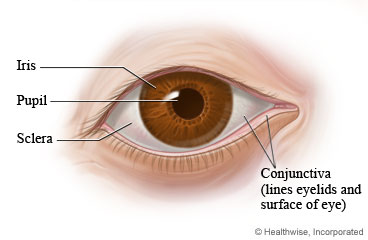Overview
Pterygium (say "teh-RIH-jee-um") and pinguecula (say "ping-GWEH-kew-luh") are similar eye problems. They are both a growth on the conjunctiva. This is the lining of the eyelid and the covering of the white part of the eye. The growths may make your eyes dry and sore.
- A pterygium grows on the cornea. This is the clear part of the eye that covers the colored part of the eye. It sometimes affects your vision.
- A pinguecula may grow close to the cornea, but it does not grow over it. It is most common in older people.
Too much exposure to the sun may play a role in these problems. They are most common in hot climates. Dry air, dust, and smoke can make them more likely to occur.
Your doctor may prescribe steroid drops to reduce redness and irritation. You also may use over-the-counter drops (artificial tears) to keep your eyes wet. If a pterygium gets big enough to cover part of the cornea, you may need surgery to remove it.
Follow-up care is a key part of your treatment and safety. Be sure to make and go to all appointments, and call your doctor if you are having problems. It's also a good idea to know your test results and keep a list of the medicines you take.


